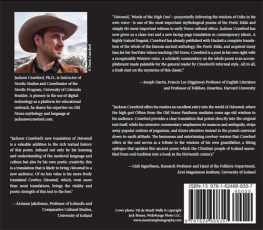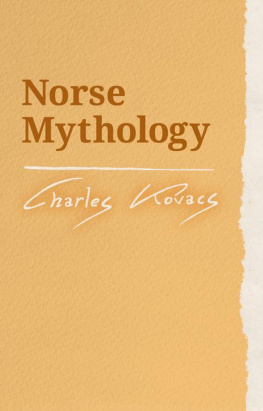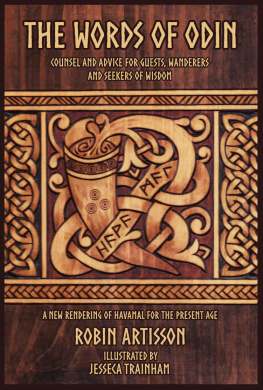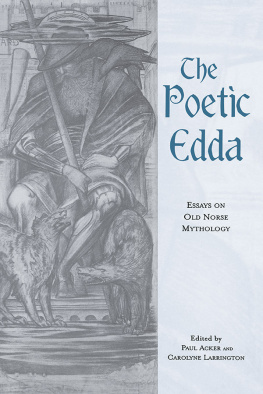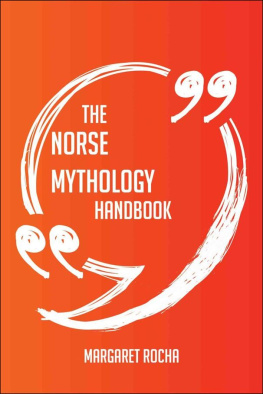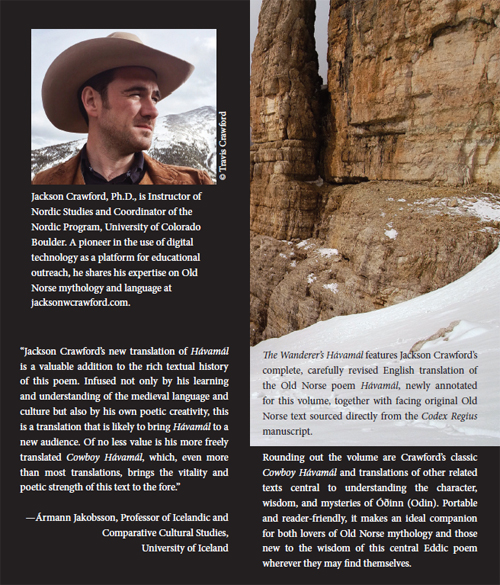CONTENTS
The Wanderers H avamal
The Wanderers H avamal
Translated and Edited, with Old Norse
Text and Related Texts, by
J ACKSON C RAWFORD
Hackett Publishing Company, Inc.
Indianapolis/Cambridge
Copyright 2019 by Hackett Publishing Company, Inc.
All rights reserved
Printed in the United States of America
22 21 20 19 1 2 3 4 5 6 7
For further information, please address
Hackett Publishing Company, Inc.
P.O. Box 44937
Indianapolis, Indiana 46244-0937
www.hackettpublishing.com
Cover design by E. L. Wilson and Brian Rak
Interior design by E. L. Wilson
Composition by Aptara, Inc.
Library of Congress Cataloging-in-Publication Data
Names: Crawford, Jackson, translator.
Title: The wanderers Hvaml / translated, with Old Norse text and related texts, by Jackson Crawford.
Other titles: Hvaml. English | Hvaml.
Description: Indianapolis : Hackett Publishing Company, Inc. 2019. | Includes bibliographical references. | Text in English and Old Norse on facing page. | Summary: The Havamal is an Old Norse poem attributed to the god Odin. Theory suggests that it was composed orally likely in the 900s AD in Norway. This translation by eminent scholar Jackson Crawford has the English translation in verse on facing pages with the Old Norse. Included also are commentary on the translational choices, related texts, and a glossary of namesProvided by publisher.
Identifiers: LCCN 2019020338 | ISBN 9781624668357 (paperback)
ISBN 9781624668425 (hardback)
Subjects: LCSH: Hvaml.
Classification: LCC PT7236.A31 2019 | DDC 839/.61dc23
LC record available at https://lccn.loc.gov/2019020338
Hardback Library of Congress Control Number: 2019909190
ePub3 ISBN: 978-1-62466-880-7
The Poetic Edda: Stories of the Norse Gods and Heroes . Translated and Edited, with Introduction, by Jackson Crawford
The Saga of the Volsungs, with The Saga of Ragnar Lothbrok . Translated and Edited, with Introduction, by Jackson Crawford
Beowulf: A New Translation for Oral Delivery . Translated, with an Introduction, by Dick Ringler
To Travis,
in all your wanderings west
Contents
Both of my translations of Hvaml, the regular translation in the style of my other Eddic translations, and the Cowboy Hvaml , have appeared earlier in The Poetic Edda: Stories of the Norse Gods and Heroes (Hackett, 2015). For several years since the publication of that book, readers have requested a standalone edition of Hvaml, ideally with the Old Norse text included. This volume aims to satisfy that demand, with the addition of light explanatory commentary on the Old Norse text, and a few other translations of Old Norse works that are not in the Poetic Edda but that shed important light on in and his Valkyries.
Additionally, since completing the original version of my Hvaml translation in 2010, I have benefitted from another nine years of reading, researching, and teaching Hvaml , and I am happy to have an opportunity to refine my translation where new facts have come to my attention or new observations have struck me. Overall, more such refinements have seemed necessary in my translations of the mysteriously worded stanzas in the latter half of the poem than in my translations of the proverbs in the first half. Where such refinements have been made, often they have reflected an attempt to let the English translation match more exactly with the wording of the original, leaving more of my own interpretation to the Commentary.
The text of Hvaml is more complicated than it might appear at first glance, and so the chance to present the Old Norse text and a commentary on it, for those who want to understand what choices I have made in the translation, is a welcome supplement. I also particularly hope that the Old Norse text and the commentary on it prove useful to readers who aspire to read Hvaml in Old Norse.
I am grateful to Brian Rak and Liz Wilson at Hackett for their help at every stage of this work. During the completion of this project , I have also been happy to enjoy the kindness and encouragement of many friends, particularly De Lane Bredvik and Gordon and Dian Bredvik ; Taylor Flint Budde; Carl Day, Jenn Green, and Skylar Day; Merlin and Barb Heinze; Faith Ingwersen; Peter and Marilyn Llewellyn ; and Matthew T. Mossbrucker. The title of this work was the fitting suggestion of Stella Bostwick, whose assistance this year has helped save hours of my time for this and other projects. At the proofs stage, the invaluable counsel of Luke Annear, Luke Gorton, Vicki Grove, Bri Panasenco, Autumn Torres, and Reggie Young aided me. And if Hvaml reminds us to be friends to those who are friends to us, I have centuries left to repay Joe and Candy Turner.
My thanks to Claire, Grandma, Kerri, Dad, and Mom for good will, and to Katherine, for helping me write some of the finest pages in my lifes chapters. And of course, it was Papa, June Crawford , whose wisdom and example still help me find the trail. I carry the fire as best I can, having seen him carry it high to the summit.
The mistakes and infelicities in this book are, of course, attributable to me alone.
Jackson Crawford
Sheridan, Wyoming
July 24, 2019
Stanzas 3150 of Hvaml from Page 04r of the Codex Regius . Image courtesy of the Stofnun rna Magnssonar slenskum frum.
Weigh words, dont count em.
western saying
Hvaml is an Old Norse poem attributed to the god in himself, and preserved together with other poems about the Norse gods and heroes in a collection called the Poetic Edda , written down in Iceland in ca. AD 1270. Linguistic evidence, as well as the pagan contents of the poem, suggests that it was composed orally at a much earlier time, probably in the 900s AD in Norway. The title Hvaml may be translated Words of the High One, or potentially Words of the One-Eyed, either one a reference to its authorship by in. Hvaml is largely made up of stanzas that use pithy, concrete language to encourage wise and practical living, but also contains the only extant account of ins mysterious sacrifice of himself to himself, as well as an account of his magical capabilities.
Hvaml is attested in only one manuscript that has survived from the Old Norse period, the Codex Regius of the Poetic Edda , written down ca. AD 1270 in Iceland. For a work that nearly did not reach the modern age, it has achieved a certain fame in the early twenty-first century, often billed as a Viking code of ethics, though that way of looking at it does little justice to the complex contents of this poem or to the universal character of its advice. More than a simple list of commandments, Hvaml uses clever imagery and succinct metaphors to encourage a patient, practical, and cynical frame of mind that was probably no more ordinary in the Viking Age than it is today. Foremost among the poems values is its emphatic call for moderationin drink, food, love, wisdom, and talk, among other pleasuresbut never for abstinence from them. Hvaml is resolutely a poem of this world, of enduring its hardships rather than of withdrawing from them.
Three-quarters of the poems stanzas are taken up with this kind of general advice, but the poem also covers some events in ins life, as well as his skills with magic and the runes. Because the poem dramatically changes subject, style, and poetic meter several times, and because even linguistic evidence suggests that at least some stanzas were composed much earlier than others, there are few modern scholars who accept the notion that Hvaml was originally composed as one continuous text (unlike most of the other poems in the Poetic Edda, which tend to be internally consistent in style and narrative). While the specific dividing lines between its constituent parts are debated, there is broad consensus that the poem can be broken into five or six portions that probably each have a separate origin in the oral literature of the Viking Age or the centuries immediately following.

